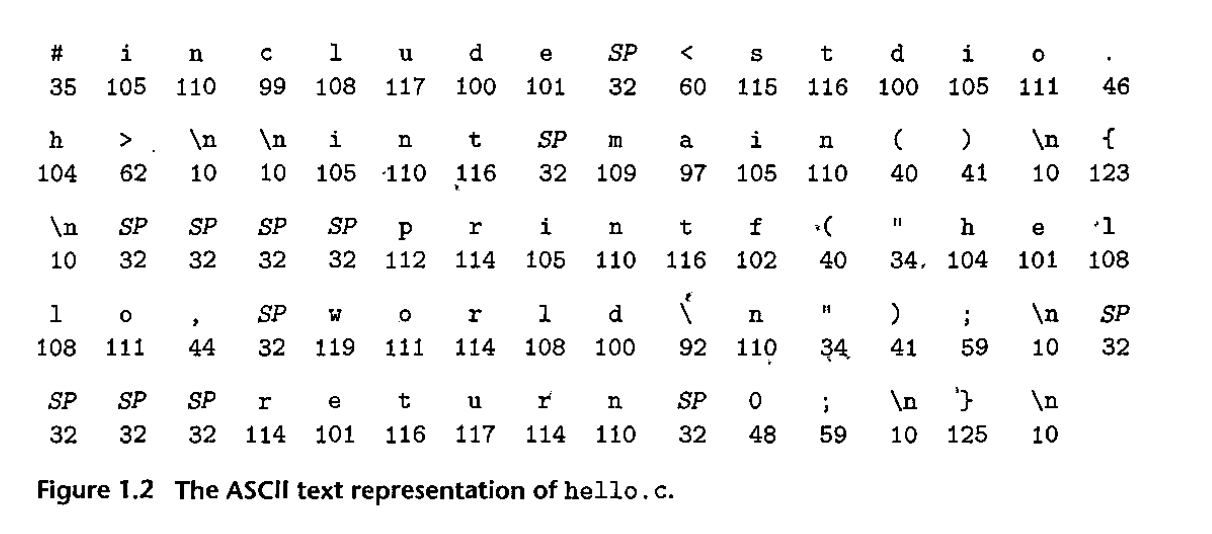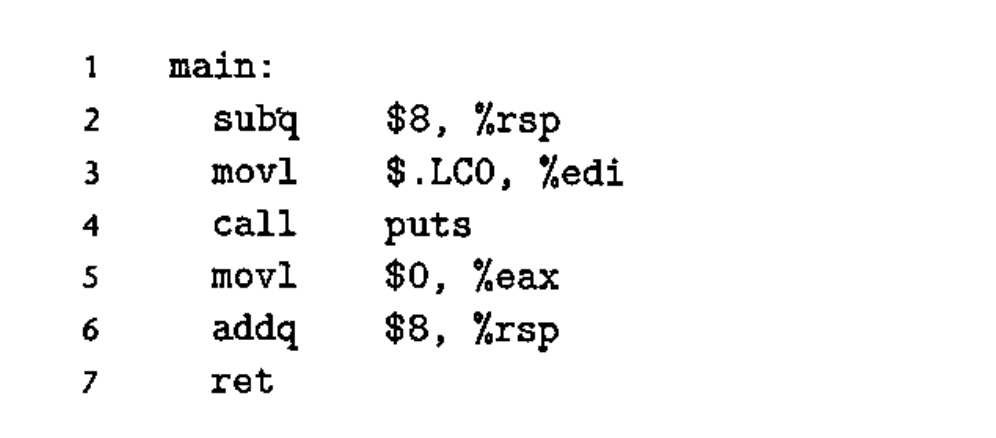Books
Computer Systems
Last updated:
Notes from reading [Compuer Systems.).
- Chapter 1:
- Chapter 2: Representing and Manipulating Information ](#chapter-two)
Chapter 1
Writing hello world in C using Visual Studio code: (https://code.visualstudio.com/docs/languages/cpp).
#include <stdio.h>
int main() {
printf("Hello, World!\n");
}Using the default compiler that ships with Mac OS - Clang.
Compile the file:
“cc hello.cCC for 'C compiler.' Execute the file (now that it's an executable)../hello`
Our hello world program begins life as a source program (or source file) hat we create with our editor and save in a text fiel called hello.c. The source program is a sequence of bits, each with a value of 0 or 1, organized in 8 bit chunks called bytes. Each byte represents some text character in the program.
Most computer systems represent text characters using the ASCII standard that represents each character with a unique byte-size integer value.

The hello.c program is stored in a file as a sequence of bytes. Each byte has an integer value that corresponds to some character.
The firt byte has an integer value 35, which corresponds to the character #.
Each text line is terminated by the invisible newline character \n Two of these in a row would be two new lines, for example.
Files such as hello.c that consist exclusively of ASCII characters are known as text files. All other files are known as binary files.
All information in a system is represented as a bunch of bits. The only thing that distinguishes different data objects is the context in which we view them. For example, in different contexts, the same sequence of bytes might represent an integer, floating-point number, character string, or machine instruction.
Our hello program stars life as a high-level C program because it can be read and understood by human beings. However, in order to run hello.c on the system, the individual C statements musst be translated by other programs into a sequence of low-level machine-language instructions. These instructions are then packaged in a form called an executable object program and stored as a binary disk file.
On a Unix system, the translation from source file to object file is performed by a compiler driver.

Here the GCC compiler driver reads the source file hello.c, and translaes it into an executable object file, hello. The translation is performed in the sequence of 4 phases shown aove. The programs that perform the 4 phase (preprocessor, compiler, assembler, and linker) are known collectively as the compilation system.
Preprocessing phase. The preprocessor (cpp) modifies the original C program according to directives that begin with the ’#’ character. For example, the #include <stdio.h> command in line 1 of hello.c tells the preprocessor to read the contents of the system header file stdio.h and insert it directly into the program text. The stdio.h heaeder files lets us perform input and output operations in C.
Compilation phase. The compiler (cc1) translates the text file hello.i into the text file hello.s, which contains an assembly-language program. This program include the following defintion of function main:

Each of lines 2-7 in this defintion describe one low-level macine-language instruction in a textual form. Assembly langauge is useful because it provides a common output language for different compilers for different high-level-languages. For example, C compilers and Fortran compilers both generate output files in the same assembly language.
Assembly phase. Next, the assembler (as) translates hello.s into machine-language instructions, packages them in a form known as relocatable object program, and stores the result in the object file hello.o. This file is a binary file containing 17 bytes to encode the instructions for function main. If we view this file with our text editor, it appears to be gibberish.
Linking phase. The printf function is part of the standard C library provided by every C compiler. The printf function resides in a seperate precompiled object file called printf.o, which must get merged with our hello.o program. The linker handles this merging. The result is the hello file, which is an execuable object file (or simply executable) that is ready to be loaded into memory and executed by thy system.
My asides
In relation to JavaScript
JavaSCript is an interpreted language, not a compiled language. With a language such as C, it needs to be compiled before it is run. The source code is passed through a program called a compiler, which translates it into bytecode that our machine understands and can then execute.
JS has no compilation step. Instead, an interpreter in the browser reads over the JS code, interprets each line, and runs it.
C Standard library
C doesn’t have built-in functions, those come from the C Standard libray.
If you’re in a unix-derived operation system, the C standard library ships with the OS - in our terminal we can do man 3 printf and look at the manual.
Chapter 2: Representing and Manipulating Information
Modern computers store and process information represented
Have questions?
Still have questions? Talk to support.